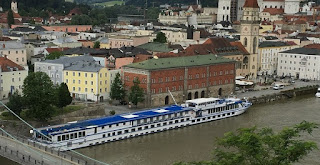Not only did we see palaces and castle/fortress ruins in many of the cities we visited, but we spent several hours one day sailing down the Rhine, gazing back and forth at castles on both shores.
Heidelberg, Germany
Fun
Facts: The Heidelberg castle was the domain of prince-electors, who elected the King of the Romans
(who was then crowned by the Pope as Holy Roman Emperor). Each prince-elector who
lived in the castle added his own space to distinguish himself from his
predecessors.
The castle has been a tourist attraction since the early 1800s, and is home to the largest wine cask in the world.
 |
| Panoramic of the castle near the entrance |
 |
| Panoramic of one of the interior castle walls |
 |
| Tower destroyed by gunpowder explosion. The castle has also been severely damaged by lightning strikes. |
 |
| In the basement of one wing you find the world's largest wine cask. The railing you see above is for a dance floor on top of the cask. |
Wertheim, Germany
Fun Facts: Construction on the Wertheim fortress began in the 12th century, and expansion continued till the 17th century. It was built to house the counts of Wertheim, and was privately owned by noble families until the town bought it in 1995.
Würzburg, Germany
Fun
Facts: The palace of the Würzburg prince-bishop took 60 years to complete, and features an unsupported vault ceiling with one of the largest frescos ever created. Despite heavy damage to the rest of the palace during World War II, the ceiling survived due to the intervention of an American soldier.
The palace was restored through images and eyewitness accounts, and includes many original furnishings. Of its 341 rooms, only 40 are open to the public.
The palace was restored through images and eyewitness accounts, and includes many original furnishings. Of its 341 rooms, only 40 are open to the public.
 |
| Photography isn't allowed inside the residence. Here's a view of the front. |
 |
| Here's a view of the back of the residence with a small portion of the beautifully landscaped gardens. |


Rhine River, Germany "Castle Pong"
Fun
Facts: There are more
than 40 castles along the Middle Rhine, which is also home to vineyards and the infamous Loreley (Lorelei) rock.
 |
| Pfalz Castle (yes, it's in the middle of the river) |
 |
| Ehrenfels Castle |
 |
| Katz Castle (unfortunately, my photo of "Maus" Castle was too blurry) |
Feelings: It turns out there is such a thing as "castle fatigue." Later in the trip, I was more content to view castles from afar if there were other things in a town to see, or my priority became climbing to a castle to see the view rather than see the castle itself.
Thankfully, with a little rest, that fatigue has lifted. I'm ready now with my list of other castles I want to see around Germany!









































